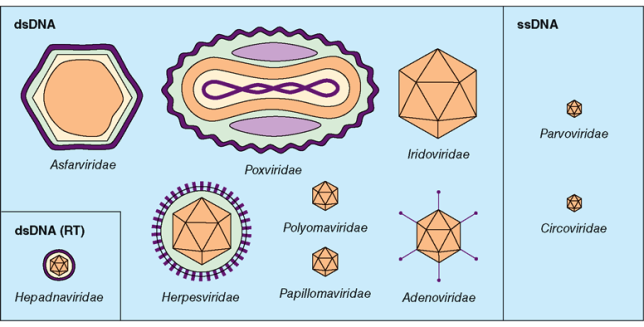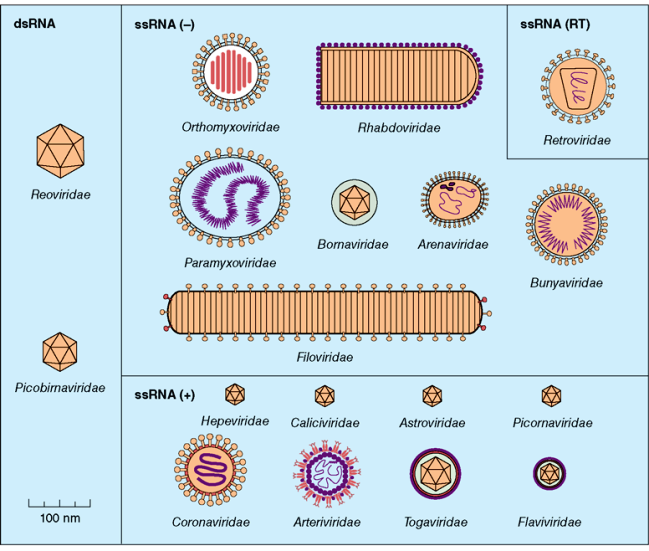Key Concepts
The taxonomic arrangement of viruses conveying how these infectious agents are related to one another. Viruses are infectious agents (typically less than 400 nanometers in diameter) that can only reproduce and metabolize from within the cells of living hosts (Fig. 1). See also: Taxonomy; Virus

The organization of viruses into a taxonomic framework is an important means for investigators to be able to study and understand the biodiversity of viruses. In general, virus classification is concerned with the naming of viruses and the assembly of these names according to a given criterion. In the classification of biological organisms, this criterion is often based on phylogenetic (evolutionary) relationships. However, there is no evidence that viruses possess a common ancestor or are in any way phylogenetically related. Nevertheless, classification along the lines of the Linnaean system (as proposed by Carolus Linnaeus in the 1700s) into families, genera, and species has been partially successful. In addition, based on the organisms that viruses infect, the first broad division used in virus classification schemes involves the separating of viruses into vertebrate viruses, invertebrate viruses, plant viruses, bacterial viruses, and algae, fungi, yeast, and protozoan viruses. (However, viral families may fall into more than one of these classes.) Within these classes, other criteria for subdivision are used, including general morphology (for example, envelope or the lack of it); nature of the genome [deoxyribonucleic acid (DNA) or ribonucleic acid (RNA)]; structure of the genome [single-stranded (ss) or double-stranded (ds), linear or circular, or fragmented or nonfragmented]; mechanisms of gene expression and virus replication (positive- or negative-sense RNA); serological relationships; host and tissue susceptibility; and pathology (symptoms or type of disease). See also: Biodiversity; Biological classification; Phylogeny; Systematics; Taxonomic categories
Typically, families of viruses are assigned the suffix -viridae as a naming convention; in addition, families are sometimes divided further into subfamilies, which are given the suffix -virinae. Further subgroups of a family or subfamily are equivalent to the genera of the Linnaean classification scheme.
Viruses infecting vertebrates
Vertebrate viruses are often classified according to their genomic content, that is, DNA or RNA. See also: Animal virus; Deoxyribonucleic acid (DNA); Ribonucleic acid (RNA); Vertebrata
DNA viruses
In general, DNA vertebrate viruses are divided into 10 families: Asfarviridae, Poxviridae, Iridoviridae, Hepadnaviridae, Herpesviridae, Polyomaviridae, Papillomaviridae, Adenoviridae, Parvoviridae, and Circoviridae (Fig. 2). Notable DNA viruses include variola virus (the cause of human smallpox), hepatitis B virus, Epstein-Barr virus, cytomegalovirus, human papillomaviruses, varicella zoster virus (the cause of chickenpox and shingles), herpes simplex viruses, and simian virus 40. See also: Adenoviridae; Chickenpox and shingles; Cytomegalovirus infection; Epstein-Barr virus; Hepatitis; Herpes; Human papillomavirus; Polyoma virus; Simian virus 40; Smallpox

RNA viruses
RNA vertebrate viruses (Fig. 3) may be either single-stranded or double-stranded. The single-stranded ones are divided further into positive-sense and negative-sense RNA viruses, depending on whether the RNA contains the messenger RNA (mRNA) nucleotide sequence or its complement, respectively. The RNA genes may be located on one or several RNA molecules (nonfragmented or fragmented genomes, respectively).

The single-stranded, positive-sense RNA vertebrate viruses contain nine families: Caliciviridae, Picornaviridae, Astroviridae, Flaviviridae, Nodaviridae, Hepeviridae, Coronaviridae, Togaviridae, and Arteriviridae. The single-stranded, negative-sense RNA vertebrate viruses are divided into seven families: Orthomyxoviridae, Paramyxoviridae, Filoviridae, Rhabdoviridae, Bornaviridae, Arenaviridae, and Bunyaviridae. The double-stranded RNA vertebrate viruses contain three groups: Reoviridae, Picobirnaviridae, and Birnaviridae. In addition, Retroviridae comprises a family of single-stranded RNA reverse-transcribing viruses. Notable RNA viruses include enteroviruses (including the polioviruses), rhinoviruses (which are responsible for the common cold), hepatitis A virus, hepatitis E virus, Ebola virus, yellow fever virus, coronaviruses [which are responsible for severe acute respiratory syndrome (SARS), Middle East respiratory syndrome (MERS), and coronavirus disease 2019 (COVID-19)], rubella virus (the cause of German measles), rabies virus, influenza viruses, bluetongue virus, measles virus, and human immunodeficiency virus [HIV; the cause of acquired immune deficiency syndrome (AIDS)]. See also: Acquired immune deficiency syndrome (AIDS); Bluetongue; Coronavirus; Ebola virus; Enterovirus; Human immunodeficiency virus (HIV); Influenza; Measles; Middle East respiratory syndrome (MERS); Paramyxovirus; Picornaviridae; Poliomyelitis; Rabies; Retrovirus; Rhinovirus; Rubella; Severe acute respiratory syndrome (SARS); Yellow fever
Viruses infecting invertebrates
Double-stranded DNA viruses that infect invertebrates (especially arthropods) comprise five families: Poxviridae, Baculoviridae, Iridoviridae, Polydnaviridae, and Ascoviridae. Single-stranded DNA viruses include two families: Parvoviridae and Circoviridae. Double-stranded RNA viruses include two families: Reoviridae and Birnaviridae. Single-stranded, negative-sense RNA viruses include two families: Rhabdoviridae and Bunyaviridae. Single-stranded, positive-sense RNA viruses include five families: Togaviridae, Flaviviridae, Picornaviridae, Tetraviridae, and Nodaviridae. Metaviridae is the only family of single-stranded RNA viruses using reverse transcriptase.
Viruses infecting plants
Double-stranded DNA viruses that infect plants include only the family Caulimoviridae. Single-stranded DNA viruses include one family: Geminiviridae. Double-stranded RNA viruses include two families: Reoviridae and Partitiviridae. Single-stranded, negative-sense RNA viruses include two families: Rhabdoviridae and Bunyaviridae. Single-stranded, positive-sense RNA viruses include many families and unassigned genera. Single-stranded RNA viruses using reverse transcriptase are contained in only one family: Pseudoviridae. It should be noted that plant viruses are sometimes placed into groups, rather than families. See also: Plant viruses and viroids
Viruses infecting bacteria
Bacterial viruses are also known as bacteriophages or phages. They may be tailed or nontailed. See also: Bacteria; Bacteriophage
Double-stranded DNA viruses that infect bacteria include nine families: Myoviridae, Siphoviridae, Podoviridae, Tectiviridae, Corticoviridae, Plasmaviridae, Lipothrixviridae, Rudiviridae, and Fuselloviridae. Single-stranded DNA viruses include two families: Inoviridae and Microviridae. Double-stranded RNA viruses include only the family Cystoviridae, whereas single-stranded RNA viruses include only the family Leviviridae.
Viruses infecting algae, fungi, yeast, and protozoa
DNA viruses that infect algae, fungi, yeast, and protozoa include one family: Phycodnaviridae. RNA viruses include double-stranded RNA viruses, single-stranded RNA viruses, and single-stranded RNA viruses that use reverse transcriptase. Double-stranded RNA viruses include three families: Totiviridae, Partitiviridae, and Hypoviridae. Single-stranded RNA viruses are contained in two families: Narnaviridae and Barnaviridae. Single-stranded RNA viruses using reverse transcriptase include two families: Pseudoviridae and Metaviridae. See also: Algae; Fungi; Protozoa; Yeast





